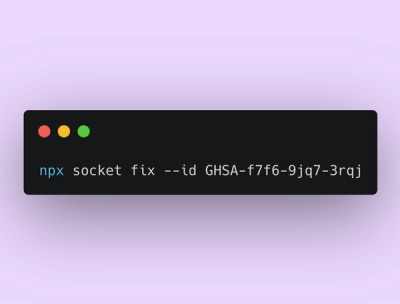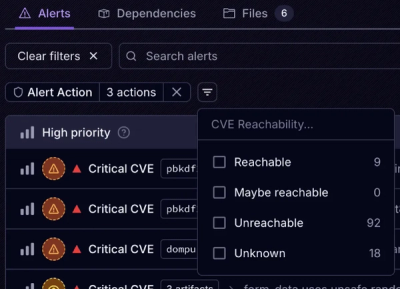
Product
Announcing Socket Fix 2.0
Socket Fix 2.0 brings targeted CVE remediation, smarter upgrade planning, and broader ecosystem support to help developers get to zero alerts.
lightningcss-cli
Advanced tools
An extremely fast CSS parser, transformer, and minifier written in Rust. Use it with Parcel, as a standalone library or CLI, or via a plugin with any other tool.


calc() expressions where possible.color-mix() functionlab(from purple calc(l * .8) a b)lab(), lch(), oklab(), and oklch() colorscolor() function supporting predefined color spaces such as display-p3 and xyzrgb and hsl functionshwb() color syntax#rgba and #rrggbbaa hex colors:not with multiple arguments:lang with multiple arguments:dir:isred 40% 80%)clamp(), round(), rem(), and mod() math functionsplace-items)overflow shorthand@media (width <= 100px) or @media (100px < width < 500px))display property (e.g. inline flex)system-ui font family fallbacks@keyframes names, grid lines/areas, @counter-style names, etc.:local() and :global() selectorscomposes propertyLightning CSS can be used from Parcel, as a standalone library from JavaScript or Rust, using a standalone CLI, or wrapped as a plugin within any other tool. See the Lightning CSS website for documentation.


$ node bench.js bootstrap-4.css
cssnano: 544.809ms
159636 bytes
esbuild: 17.199ms
160332 bytes
lightningcss: 4.16ms
143091 bytes
$ node bench.js animate.css
cssnano: 283.105ms
71723 bytes
esbuild: 11.858ms
72183 bytes
lightningcss: 1.973ms
23666 bytes
$ node bench.js tailwind.css
cssnano: 2.198s
1925626 bytes
esbuild: 107.668ms
1961642 bytes
lightningcss: 43.368ms
1824130 bytes
For more benchmarks comparing more tools and input, see here. Note that some of the tools shown perform unsafe optimizations that may change the behavior of the original CSS in favor of smaller file size. Lightning CSS does not do this – the output CSS should always behave identically to the input. Keep this in mind when comparing file sizes between tools.
FAQs
A CSS parser, transformer, and minifier written in Rust
The npm package lightningcss-cli receives a total of 8,823 weekly downloads. As such, lightningcss-cli popularity was classified as popular.
We found that lightningcss-cli demonstrated a healthy version release cadence and project activity because the last version was released less than a year ago. It has 1 open source maintainer collaborating on the project.
Did you know?

Socket for GitHub automatically highlights issues in each pull request and monitors the health of all your open source dependencies. Discover the contents of your packages and block harmful activity before you install or update your dependencies.

Product
Socket Fix 2.0 brings targeted CVE remediation, smarter upgrade planning, and broader ecosystem support to help developers get to zero alerts.

Security News
Socket CEO Feross Aboukhadijeh joins Risky Business Weekly to unpack recent npm phishing attacks, their limited impact, and the risks if attackers get smarter.

Product
Socket’s new Tier 1 Reachability filters out up to 80% of irrelevant CVEs, so security teams can focus on the vulnerabilities that matter.